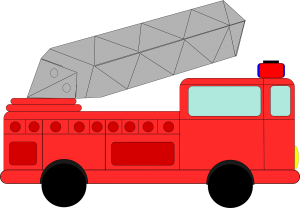 I held up two books and ask Joey which one he wanted to read. He said “fire engine” with his eye gaze device, and then looked at Curious George and the Fire Fighters that was hiding behind my chair and NOT one of the choices I offered. OK. Here’s the thing. When Joey and I read Curious George and the Fire Fighters we never actually get through the whole book. Sometimes I have a compulsion to finish a book, and so this pattern drives me a bit crazy. So I don’t always offer Curious George and the Fire Fighters as an option. “Fire engine” Joey said again. [Read more…]
I held up two books and ask Joey which one he wanted to read. He said “fire engine” with his eye gaze device, and then looked at Curious George and the Fire Fighters that was hiding behind my chair and NOT one of the choices I offered. OK. Here’s the thing. When Joey and I read Curious George and the Fire Fighters we never actually get through the whole book. Sometimes I have a compulsion to finish a book, and so this pattern drives me a bit crazy. So I don’t always offer Curious George and the Fire Fighters as an option. “Fire engine” Joey said again. [Read more…]
Reconnecting
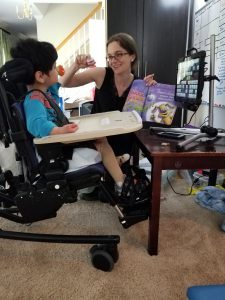 Unfortunately, Joey and I were apart for almost a full month in April because I broke my ankle and couldn’t drive. It was wonderful to finally get back to see him last week. In just a month it seemed that he’d grown multiple inches! I was hoping that we’d easily get right back into our familiar pattern, and I hadn’t planned to do anything different or out of the ordinary during our sessions. I was excited to read Harry the Dirty Dog with him, so I dove right in with my plans.
Unfortunately, Joey and I were apart for almost a full month in April because I broke my ankle and couldn’t drive. It was wonderful to finally get back to see him last week. In just a month it seemed that he’d grown multiple inches! I was hoping that we’d easily get right back into our familiar pattern, and I hadn’t planned to do anything different or out of the ordinary during our sessions. I was excited to read Harry the Dirty Dog with him, so I dove right in with my plans.
Joey had other ideas. He wanted to talk. He listed every animal on his device, and then listed them again. He told me about helicopters and airplanes and occasionally let me read a page or two of the book. At one point he used his device to say “stop mouth” which I’m pretty sure was his way of asking me to stop reading so he could talk. That was one of the only phrases he used during that time. What was going on? The last time I’d been there Joey was full of early phrases and was starting to explore pronouns. And now?
We were both frustrated and both of us felt like we weren’t getting anywhere. I had to take a step back and remember that our relationship is more important than the work I’d carefully planned. (Didn’t he realize that Harry is such a fun book?) I’d just brought myself and my show to the table, and I hadn’t left any room for Joey. I think we do this often as teachers, especially at this time of the year when we are feeling the deadlines of the end of the school year approaching. Luckily, I don’t have that worry with Joey, but I think I did want to make up for lost time.
I needed to back up, slow down, and remember the boy in front of me. The smiling four-year-old with so much to say. So I paused, listened, nodded, and tried to acknowledge his list of animals. Once we were connected, we could move forward.
And we did. After re-connecting and taking time to rebuild the relationship, Joey dropped his musical shaker on the floor. He looked at what he’d dropped and then at his device. Carefully he selected different hear and then looked at the other egg shaker sitting on the table. He was asking for other musical instrument – the other instrument he can hear. We were back to meaningful communication with two word phrases.
It’s easy to forget how important our relationships with our kids are, and how much more they are capable of when we are working with them instead of teaching at them.
*On another note, I do not think Joey appreciates Harry the Dirty Dog like I do. Instead we are now reading Groovy Joe, which is a bit faster and more animated.
Preparing Harry the Dirty Dog to read with Joey
I’m very excited about introducing Joey to anothe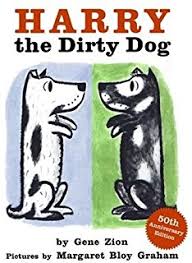 r of my favorite books – Harry the Dirty Dog by Gene Zion. For those of you not familiar with the story, Harry is a white dog with black spots who hates baths. One day he runs away from home and becomes so dirty that when he finally returns home his family no longer recognizes him, even when he does all his tricks. Finally, he runs into the bathtub and begs for the family to give him a bath. Once he’s clean, the family realizes that the dog in their tub is actually Harry and Harry learns that baths aren’t so bad after all.
r of my favorite books – Harry the Dirty Dog by Gene Zion. For those of you not familiar with the story, Harry is a white dog with black spots who hates baths. One day he runs away from home and becomes so dirty that when he finally returns home his family no longer recognizes him, even when he does all his tricks. Finally, he runs into the bathtub and begs for the family to give him a bath. Once he’s clean, the family realizes that the dog in their tub is actually Harry and Harry learns that baths aren’t so bad after all.
To get ready to read Harry with Joey, I’ve gotten a small stuffed white dog, and velcroed black spots to him. I also have a toy bathtub and a pretend scrub brush. I’ve added boardmaker pictures icons to the book to draw attention to key concepts in the book, such as the opposites of clean/dirty, and Harry’s emotions as he goes from happy, to sad, to happy again.
My main goal for this book will be for us to act out the story together, while engaging in back and forth reciprocal communication.
Harry is a fun book for children this age because it adds a certain sense of naughtiness as Harry runs away from home and does whatever he wants, regardless of how dirty he becomes. The story also lets us focus on the concept of comparisons as Harry becomes dirtier and dirtier. At first there is no dirt, then a little, then a medium amount, and finally – there is so much dirt that Harry is covered in black. Retelling this part of the story will work on Joey’s sequencing skills as well, as he helps us put part of the story in order.
To work on Joey’s early literacy skills, we’ll focus on the letters H and D, for Harry, Dog and Dirty. We’ll add pictures of dirty, dog, and harry to Joey’s alphabet book. To support Joey’s growing math skills, we’ll count the number of black felt spots we use to turn the Harry stuffed animal from a white dog to a black dog. We’ll also play a game where we roll a dice use a black marker to add that many dots onto an outline of a white dog.
Most of all though, I’m hoping to use Harry as a chance for Joey and I to play and interact. We can be silly as roll the stuffed dog through the felt and get him dirty. We can pretend to scold that dirty dog, and pretend to give him a bath. When we read the book with Joey on the floor, he can pretend he is Harry, and can roll around to get dirty just like Harry.
You can hear Betty White read it on the Screen Actor’s Guild’s website, Storyline Online.
Prompting Hierarchy for Augmentative and Alternative Communication
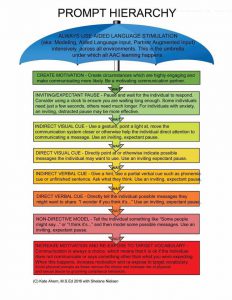 Before I became a special education teacher I hadn’t put much thought into prompting, different types of prompts, or how important it is to be aware of the prompts we give our students. Yet now, I think of a strong understanding of prompts with wait time to be one of the most important gifts we can give our students. So of course, I was thrilled when I came across this prompting hierarchy chart made specifically for students using Augmentative and Alternative Communication devices, by Kate Ahmed and Shelane Nielson.*
Before I became a special education teacher I hadn’t put much thought into prompting, different types of prompts, or how important it is to be aware of the prompts we give our students. Yet now, I think of a strong understanding of prompts with wait time to be one of the most important gifts we can give our students. So of course, I was thrilled when I came across this prompting hierarchy chart made specifically for students using Augmentative and Alternative Communication devices, by Kate Ahmed and Shelane Nielson.*
Using this prompting hierarchy communicates respect and high expectation to the student, encouraging him to do his best. We start at the top, creating motivation and opportunities for the child to express himself. Only after the child is unresponsive do we move down the chart.
I love that this chart starts with creating motivation and providing a pause so that the student has time to respond. This motivation does not mean encouraging the child to earn a reward by choosing the “right” words on his talker. Instead, this implies we need to provide the child with engaging lessons where the child wants to engage with us. For Joey, this means books about fire engines, dinosaurs, and ducks. It’s not about choosing my favorite books, but instead choosing books and activities that make Joey want to tell me about the pictures, answer my questions, or ask to play with a toy fire truck.
The next step, providing the pause, or wait time, is essential. We all need time to find our words (even if we don’t use an AAC.) Some of us are just faster at finding our words than others. Although waiting for a child to find their words can be uncomfortable for the adult, we need to learn to sit with our discomfort and . You can read more about the importance of wait time here.
The next steps in the chart go through different types of discreet prompts, with in-direct then direct visual cues, in-direct then direct verbal cues, and non-direct modeling. It’s important to remember that visual cues are less intrusive than verbal cues, and easier to fade. Therefore, in any prompting hierarchy, we try to use visual or gestural prompts before resorting to verbally telling a child what to do. The idea is always to be able to fade our level of prompting so the child will become independent. Too many verbal prompts will interfere with the goal of independence.
My favorite part of the chart is the non-direct model, which suggests using language like “some people may say”. This indicates to the child that they could use these words if they wanted to, but that they still have control over what words they choose to use.
*I saw this chart on the Facebook Group, Motivate, Model, and Move Out of the Way. I’ve also found it on Pinterest, but am having trouble finding where it originated from.
Getting Moving!
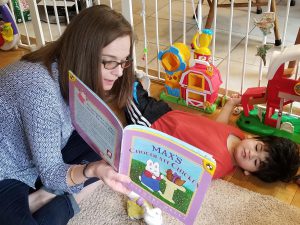 When Joey turned four I reviewed the developmental stages of typical four-year-olds, and was reminded of how much this age group loves physical activity. Gross motor movement is not always easy to incorporate into my work with Joey because we spend so much time with him in his chair reading books and using his AAC device. I made a mental note to remind myself to plan activities that could be done down on the floor with Joey so that I could meet his four-year-old need for physical activity, while also working on some of our other goals.
When Joey turned four I reviewed the developmental stages of typical four-year-olds, and was reminded of how much this age group loves physical activity. Gross motor movement is not always easy to incorporate into my work with Joey because we spend so much time with him in his chair reading books and using his AAC device. I made a mental note to remind myself to plan activities that could be done down on the floor with Joey so that I could meet his four-year-old need for physical activity, while also working on some of our other goals.
Rosemary Well’s book, Max’s Chocolate Chicken, provided a great opportunity to get Joey onto the floor and moving to look for eggs just like Max and Ruby. The simple storyline makes Max’s Chocolate Chicken is a fun egg-hunt themed book to use with preschoolers. Max and his sister Ruby are on an egg hunt, and the winner gets a chocolate chicken. Unfortunately for Max, Ruby finds most of the eggs, while he explores the outdoors the way any toddler or preschooler should. Eventually, Max grows tired of Ruby’s taunts and hides away to eat the chocolate chicken, ignoring all the rules of the egg hunt. In true Max and Ruby fashion, it’s a silly story that seems to capture childhood intentions.
 Joey and I read this book on the floor to fully engage in egg hunt fun. I brought out my Max and Ruby dolls so we could act out the story, but I also had eggs with farm stickers inside (Joey loves farm animals) so that we could have our own egg hunt. After acting out the story with the dolls and the eggs, I rolled the eggs around the floor so that Joey could have an egg hunt of his own.
Joey and I read this book on the floor to fully engage in egg hunt fun. I brought out my Max and Ruby dolls so we could act out the story, but I also had eggs with farm stickers inside (Joey loves farm animals) so that we could have our own egg hunt. After acting out the story with the dolls and the eggs, I rolled the eggs around the floor so that Joey could have an egg hunt of his own.
Once I became a parent I began to appreciate the pure beauty of the spring egg hunt. It is a whole-body, integrated activity, that can provide practice for visual-spatial processing, motor planning, receptive language, number sense (counting the eggs) and problem-solving techniques when finding those hard to reach eggs. And it’s so simple. We hide eggs and kids run to find them. We can give them clues about where the eggs are hiding (working on receptive language), and encourage them to develop their problem solving skills in figuring out how to get some of the harder to reach eggs. Collecting and counting the eggs provides great practice with early number sense. It is a shame it becomes such a seasonal activity, because we could do so much with this type of activity all year long.
Our egg hunt for Joey also gave him gross motor, visual-spatial processing and motor planning practice as he navigated his way to the eggs. Joey is an expert at moving around his living room when he is motivated, and it is always unbelievable to watch him move from one side of the room to the other to get something he wants. Although this is not always a straight forward task for him, he puts in the additional level of focus his body requires to coordinate his arms and legs to roll in the right direction. I love being able to watch Joey use his full body to engage in our activities, because you can see just how his mind works to plan getting himself from one place to another.
It is a shame egg hunts are such seasonal activities. I need to find some other open-ended activities that provide us with more opportunities to work on the floor.
- « Previous Page
- 1
- …
- 26
- 27
- 28
- 29
- 30
- …
- 38
- Next Page »


